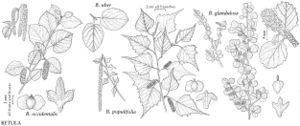Difference between revisions of "Betula papyrifera"
Arbust. Amer., 19. 1785.
FNA>Volume Importer |
FNA>Volume Importer |
||
| Line 45: | Line 45: | ||
}}<!-- | }}<!-- | ||
| − | --><span class="statement" id="st- | + | --><span class="statement" id="st-undefined" data-properties=""><b>Trees,</b> to 30 m, usually 20 m or shorter; trunks often single, sometimes 2 or more, mature crowns narrowly round. <b>Bark</b> of young trunks and branches dark reddish brown, smooth, in maturity creamy to chalky white or pale to (infrequently) dark brown, readily exfoliating in paper-thin sheets; lenticels pale, horizontal, in maturity dark, much expanded, horizontal. <b>Twigs</b> without strong odor and taste of wintergreen, slightly to moderately pubescent, infrequently with scattered, small, resinous glands. <b>Leaf</b> blade ovate with 9 or fewer pairs of lateral veins, 5–9(–12) × 4–7 cm, base rounded, cuneate, or truncate, margins sharply to coarsely or irregularly doubly serrate or serrate-dentate, apex acute to short-acuminate; surfaces abaxially sparsely to moderately pubescent, often velutinous along major veins and in vein axils, covered with minute, resinous glands. <b>Infructescences</b> pendulous, cylindric, 2.5–5 × 0.6–1.2 cm, readily shattering with fruits in late fall; scales pubescent to glabrous, lobes diverging at or proximal to middle, central lobe narrowly elongate, obtuse, lateral lobes about equal in length to central lobe but several times broader, strongly divergent, held nearly at right angles to axis. <b>Samaras</b> with wings as broad as or slightly broader than body, extended nearly beyond body apically. <b>2n</b> = 56, 70, 84.</span><!-- |
-->{{Treatment/Body | -->{{Treatment/Body | ||
| Line 79: | Line 79: | ||
|publication year=1785 | |publication year=1785 | ||
|special status=Endemic;Selected by author to be illustrated | |special status=Endemic;Selected by author to be illustrated | ||
| − | |source xml=https://jpend@bitbucket.org/aafc-mbb/fna- | + | |source xml=https://jpend@bitbucket.org/aafc-mbb/fna-data-curation.git/src/9216fc802291cd3df363fd52122300479582ede7/coarse_grained_fna_xml/V3/V3_85.xml |
|subfamily=Betulaceae subfam. Betuloideae | |subfamily=Betulaceae subfam. Betuloideae | ||
|genus=Betula | |genus=Betula | ||
|species=Betula papyrifera | |species=Betula papyrifera | ||
| − | |||
| − | |||
| − | |||
| − | |||
| − | |||
| − | |||
| − | |||
| − | |||
| − | |||
| − | |||
| − | |||
| − | |||
| − | |||
| − | |||
| − | |||
| − | |||
| − | |||
| − | |||
| − | |||
| − | |||
| − | |||
| − | |||
| − | |||
| − | |||
| − | |||
| − | |||
| − | |||
| − | |||
| − | |||
| − | |||
| − | |||
| − | |||
| − | |||
| − | |||
| − | |||
| − | |||
| − | |||
| − | |||
| − | |||
| − | |||
| − | |||
| − | |||
}}<!-- | }}<!-- | ||
-->[[Category:Treatment]][[Category:Betula]] | -->[[Category:Treatment]][[Category:Betula]] | ||
Revision as of 14:51, 27 July 2019
Trees, to 30 m, usually 20 m or shorter; trunks often single, sometimes 2 or more, mature crowns narrowly round. Bark of young trunks and branches dark reddish brown, smooth, in maturity creamy to chalky white or pale to (infrequently) dark brown, readily exfoliating in paper-thin sheets; lenticels pale, horizontal, in maturity dark, much expanded, horizontal. Twigs without strong odor and taste of wintergreen, slightly to moderately pubescent, infrequently with scattered, small, resinous glands. Leaf blade ovate with 9 or fewer pairs of lateral veins, 5–9(–12) × 4–7 cm, base rounded, cuneate, or truncate, margins sharply to coarsely or irregularly doubly serrate or serrate-dentate, apex acute to short-acuminate; surfaces abaxially sparsely to moderately pubescent, often velutinous along major veins and in vein axils, covered with minute, resinous glands. Infructescences pendulous, cylindric, 2.5–5 × 0.6–1.2 cm, readily shattering with fruits in late fall; scales pubescent to glabrous, lobes diverging at or proximal to middle, central lobe narrowly elongate, obtuse, lateral lobes about equal in length to central lobe but several times broader, strongly divergent, held nearly at right angles to axis. Samaras with wings as broad as or slightly broader than body, extended nearly beyond body apically. 2n = 56, 70, 84.
Phenology: Flowering late spring.
Habitat: Moist, ± open, upland forest, especially on rocky slopes, also sometimes in swampy woods
Elevation: 300–900 m
Distribution

St. Pierre and Miquelon, Alta., B.C., Man., N.B., Nfld., N.W.T., N.S., Ont., P.E.I., Que., Sask., Yukon, Alaska, Colo., Conn., Idaho, Ill., Ind., Iowa, Maine, Mass., Mich., Minn., Mont., Nebr., N.H., N.J., N.Y., N.Dak., Oreg., Pa., R.I., S.Dak., Vt., Va., Wash., Wis., Wyo.
Discussion
Betula papyrifera is a well-known tree of the northern forest with its paper-thin, white, peeling bark. The bark, which has a high oil content and is consequently waterproof, was used for a wide variety of building and clothing purposes by the American Indians, including the covering of the familiar birch bark canoe. It is still used for various purposes, including basketmaking, in Canada and Alaska. Variants having more or less close, dark brown bark (B. papyrifera var. commutata) occur locally throughout the wide range of this species; this characteristic appears to be largely environmentally caused. The species is an important successional tree, coming up readily after fires, logging, or the abandonment of cultivated land. The relatively soft, whitish wood is used extensively for such items as clothespins, spools, ice cream sticks, and toothpicks, as well as for pulpwood for paper.
Betula papyrifera is the state tree of New Hampshire.
Native Americans use Betula papyrifera medicinally in enemas, to shrivel the womb, to alleviate stomach cramps and pain, and as a tonic (D. E. Moerman 1986).
Betula ×sandbergii Britton is a fairly common hybrid, occurring where the ranges of the parents (B. papyrifera Marshall and B. pumila Linnaeus) come into contact. In most vegetative features it is intermediate between the parental conditions (K. E. Clausen 1963; C. O. Rosendahl 1928).
Selected References
None.
